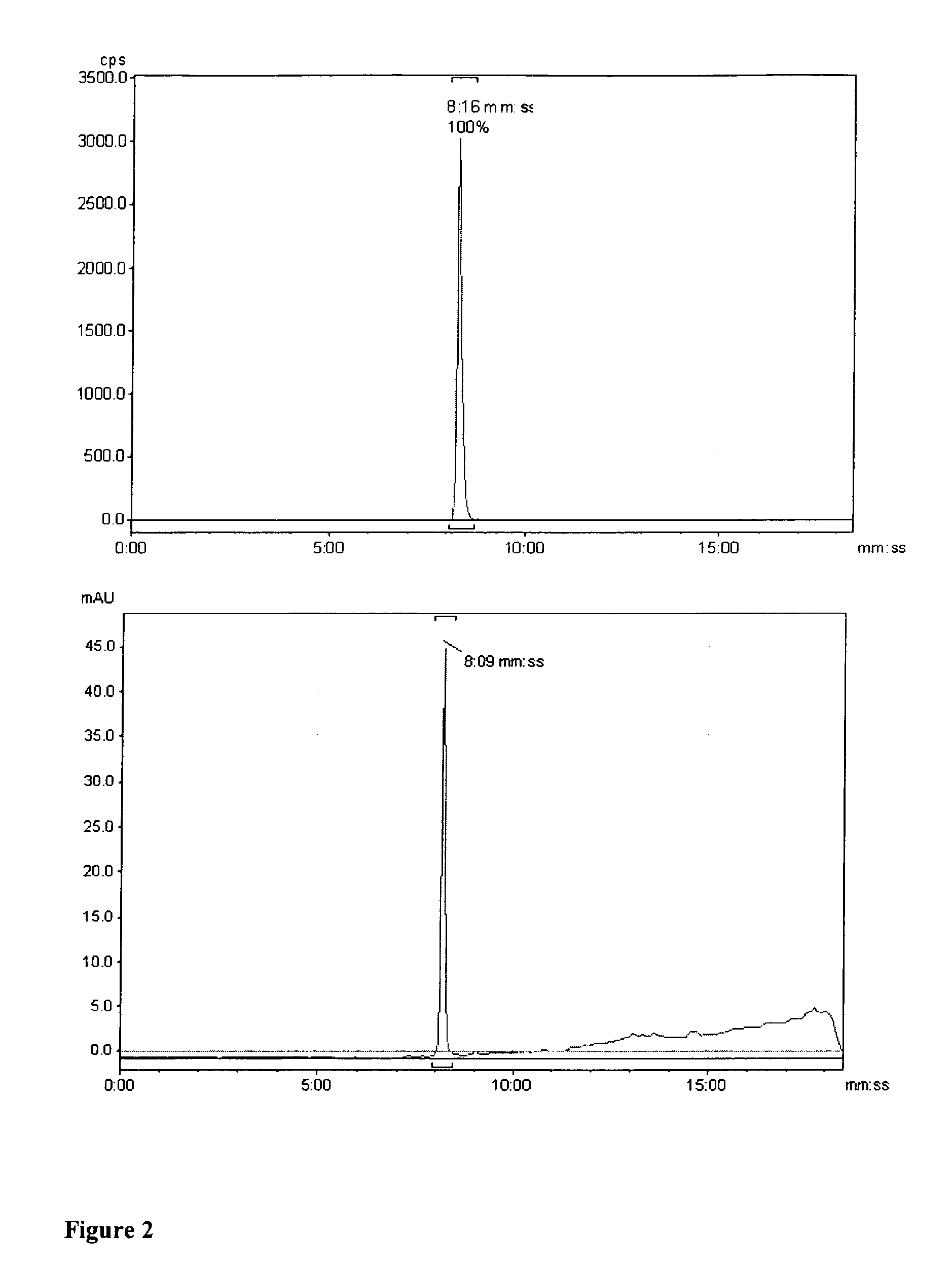Radiofluorination
a radiofluorination and fluorination technology, applied in the field of radiofluorination, can solve the problems of poor radiochemistry, difficult direct nucleophilic radiofluorination with no-carrier-added [sup>18/sup>f]-fluoride, and difficult cyclisation of alkyls, etc., to facilitate the production of a range of radiofluorinated amide and amine compounds, and facilitate the production of amin
- Summary
- Abstract
- Description
- Claims
- Application Information
AI Technical Summary
Benefits of technology
Problems solved by technology
Method used
Image
Examples
example 1
Preparation of 2-[18F]Fluoroethylamine
[0135]To a conical glass vial (Wheaton, 2 ml) were added a plug of copper wire (0.1 mm, 90-110 mg), acid (100 μl, 20% in water), and 2-[18F]fluoroethylazide (100 μl, 279-313 μCi, prepared as described in M. Glaser and E. Årstad, Bioconj. Chem. 2007; 18: 989). The vial was heated at 80° C. for 30 min and an aliquot analyzed by HPLC (column LunaC18, 50×4.6 mm, 3 μm, solvent A: water (0.1% TFA), solvent B: acetonitrile (0.1% TFA), flow 1 ml / min, gradient 5 to 80% solvent B in 15 min, λ=254 nm). The product peak eluted with the solvent front (tR=45 s).
[0136]2-[18F]Fluoroethylamine was prepared in good yields from 2-[18F]fluoroethylazide / copper(0) when the acid used was 10% phosphoric acid, 10% sulfuric acid or 10% methane sulfonic acid. In comparison, when the acid was hydrochloric acid, the yield was relatively low (Table 1).
TABLE 1Radiochemical yields of 2-[18F]fluoroethylamine using alternative acidsin the Cu(0) reduction method with 2-[18F]fluor...
example 2
Two-pot Preparation of 9H-beta-carboline-3-carboxylic acid (2-[18F]fluoroethyl)amide and Subsequent Formulation
[0137]
[0138]2-[18F]fluoroethylazide (17 mCi, prepared as described in M. Glaser and E. Årstad, Bioconj. Chem. 2007; 18: 989-993) in acetonitrile (35 μl) was added to a conical vial containing a plug of copper wire (0.1 mm, 114 mg), followed by a solution of TFA in water (10%, 45 μmol, 35 μl). After heating for 30 min at 80° C., more acetonitrile (50 μl) was added and the reaction solution transferred into another vial. Triethylamine (27 μl, 227 μmol) was added followed by a solution of 9H-beta-Carboline-3-carboxylic acid pentafluorophenyl ester (4 mg, 10.6 μmol; prepared by esterification of the corresponding carboxylic acid, which was obtained by the methods described in EP0030254) in DMF (50 μl). The mixture was heated for 15 min at 80° C. and filtered (Eppendorf pipette tip with plug of tissue). The filter was rinsed with additional acetonitrile (100 μl). HPLC mobile pha...
example 3
One-pot Preparation of 91′-beta-carboline-3-carboxylic acid (2-[18 F]fluoroethyl)amide
[0140]A Wheaton vial (1 ml) was charged with a plug of copper wire (116 mg, Goodfellow, Cat. No. CU005240 / 1), aqueous methanesulfonic acid (100 μl, 14.8 mg, 0.154 mmol, 10% v / v), and 2-[18F]-fluoroethylazide (12.4 mCi in 100 μl acetonitrile, prepared as described in M. Glaser and E. Årstad, Bioconj. Chem. 2007; 18: 989-993). After heating for 30 min at 80° C., triethylamine (90 μl, 0.770 mmol) was added. A solution of 9H-beta-Carboline-3-carboxylic acid pentafluorophenyl ester (4 mg, 10.6 mop in DMF (50 μl) was added. The mixture was incubated for 15 min at 80° C. and subsequently diluted with acetonitrile (100 μl). The reaction solution was filtered (PTFE Acrodisc, 0.45 μm) and injected onto the preparative HPLC. FIG. 4 shows the preparative HPLC chromatogram for 9H-beta-Carboline-3-carboxylic acid (2-[18F]fluoro-ethyl)-amide using one-pot method (top: radioactivity channel, bottom: UV channel, 25...
PUM
| Property | Measurement | Unit |
|---|---|---|
| Capacitance | aaaaa | aaaaa |
Abstract
Description
Claims
Application Information
 Login to View More
Login to View More - R&D
- Intellectual Property
- Life Sciences
- Materials
- Tech Scout
- Unparalleled Data Quality
- Higher Quality Content
- 60% Fewer Hallucinations
Browse by: Latest US Patents, China's latest patents, Technical Efficacy Thesaurus, Application Domain, Technology Topic, Popular Technical Reports.
© 2025 PatSnap. All rights reserved.Legal|Privacy policy|Modern Slavery Act Transparency Statement|Sitemap|About US| Contact US: help@patsnap.com



